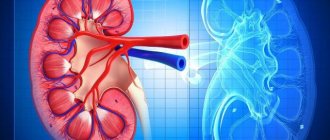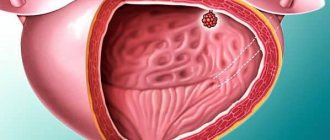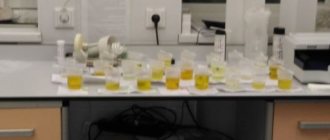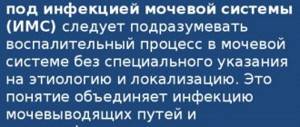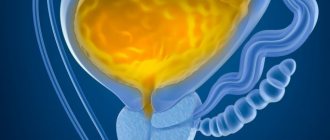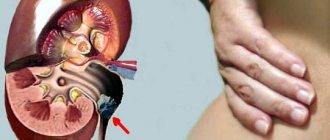Urodynamic examination of the bladder is a set of diagnostic methods aimed at identifying diseases of the genitourinary system.
Unlike most diagnostic methods used in the presence of obvious pathology, UDI helps to detect hidden conditions that can develop into more serious complications.
During such a comprehensive diagnosis, the doctor receives a holistic picture of the organ being examined, including the dynamics of all its functions.
- Contraindications
Goals and indications for urodynamic study
Urodynamics refers to the general process of the bladder and related organs removing urine from the body. Thus, the purpose of a urodynamic study is to assess the storage and evacuation functions of the urinary system.
UDI methods are particularly accurate, which helps to reliably determine the probable preconditions for certain dysfunctions.
During a urodynamic study, the general sensitivity of the bladder is first determined, the work of the urethra is assessed when it is full, and possible overactivity of the detrusor, the muscular lining of the bladder, .
In addition, urethral resistance during urination and the amount of residual urine are measured. Based on the results obtained, the diagnosis is adjusted and specific treatment methods are selected.
As a rule, a urodynamic study of the bladder is prescribed if the following problems exist:
- Urinary incontinence during exercise or spontaneous muscle contractions.
- Involuntary leakage of urine with a strong urge to urinate.
- Rare or frequent urination.
- Difficulty or painful urination.
- Pain in the bladder area.
- Dullness or complete absence of a feeling of fullness of the bladder,
- Desuria.
- Polyuria.
- Chronic forms of diseases that are not amenable to conventional therapeutic effects (chronic pyelonephritis, cystitis, prostatitis, etc.).
Also, urodynamic examination of the bladder may be prescribed to patients before surgical operations related to the genitourinary system.
Features and methods of the procedure
A comprehensive urodynamic study (abbreviated CUDI) means an examination of the urinary tract. It is used in the diagnosis of diseases associated with dysfunction of this system.
KUDI includes a set of methods, such as:
- Uroflowmetry. Based on the study of the volumetric flow rate of urine.
- Cystometry. It involves determining intravesical pressure (requires filling the organ with sterile saline solution through a thin catheter). The procedure does not cause pain.
- Profilometry. This method is aimed at determining the pressure that is generated during urine retention through a catheter. They resort to profilometry to determine the nature of incontinence or difficulty urinating.
- Electromyography. This procedure is based on measuring the impulses that the nervous system sends. Prescribed in cases where the doctor suspects that physiological problems are caused by damage to soft tissues or nerves. This test measures muscle activity in the urethra and in the area around it.
- "Pressure-flow". This method simultaneously records 2 different indicators. Actually, it allows you to monitor the flow of urine and the pressure of the soft tissues of the detrusor.
The results of CUDI allow you to obtain information regarding the condition of the urinary organs and determine the causes of problems that have arisen.
Preparatory stage
Preparation for urodynamic examination of the bladder is carried out under the supervision of a physician. In this case, the general condition of the patient is taken into account, on the basis of which, among other things, decisions are made on the appropriateness of taking certain medications before UDI.
To establish a clear clinical picture, the patient is recommended to keep a urination diary for 5-7 days before the start of diagnostic procedures. It should record the time, frequency of urination and volume of urine. It is also advisable to make notes about the liquid you drink.
Types of research
Urodynamic studies are divided into 2 types: inpatient and outpatient, depending on the location of the diagnosis.
Inpatient urodynamics
Traditional urodynamic testing is performed in the clinic. In this case, the doctor fills the bladder with a special liquid of a certain temperature through a catheter, regulating the speed of its passage through the urinary tract.
Standard urodynamic diagnostics include studies such as uroflowmetry, cystometry, cystoscopy, pressure-flow, electromyography, etc.
Outpatient urodynamics
Outpatient urodynamic study of the urination process is carried out on an outpatient basis. In this case, the natural process of filling the bladder and eliminating urine is examined.
The patient needs to keep a special diary in which he records how much fluid is consumed per day and how much is excreted from the body.
The duration of keeping a diary is 2-3 days. The method allows you to assess the functional volume of an organ.
Analysis of urine
Morning urine accumulated overnight is best suited for laboratory research - its analysis provides the most objective data. A general urine test allows you to determine the presence of abnormalities associated with inflammatory processes, identify the pathogen, and also detect long-term signs of some diseases not related to the genitourinary system.
Features of preparation
Typically, KUDI does not require compliance with any special rules or preliminary measures. However, it is recommended to undergo a general urine test before the procedure. Against the background of its results, it is possible to determine or exclude the occurrence of inflammatory processes in the body at the time of the urodynamic study.
Before the manipulations themselves, you will need to cleanse the body and perform genital hygiene. Women need to monitor their cycle; KUDI is not performed during menstruation.
In some cases, after an examination, the doctor may prescribe a short-term course of antibiotics to prevent inflammatory processes.
Urofluometry
Urofluometry is a relatively simple diagnostic test that measures the rate of urination and the volume of urine excreted. An hour before the start of the procedure, the subject must drink at least one liter of liquid.
Measurements are carried out using special equipment that records all the required parameters. The patient can perform the necessary manipulations in private on his own by pressing the start button of the urofluometer when ready to urinate. Data in the form of graphs is displayed on the computer screen.
Contraindications for performing CODI
A comprehensive urodynamic examination, like any other diagnostic procedure, cannot be performed on everyone.
Contraindications include infectious inflammation of the lower urinary tract (including the urethra) in acute form.
Other contraindications include the presence of neoplasms in the lower urinary tract and congenital anatomical pathologies.
Cystometry
With this examination method, such parameters of the bladder as capacity, sensitivity of its walls, intravesical pressure in the empty and filled state, as well as the functional characteristics of the detrusor and urethra are studied.
Using cystometry, you can determine the presence of pathological conditions such as detrusor hyperreflexia (the occurrence of detrusor contractions when there is a relatively small amount of fluid in the bladder) or detrusor areflexia (the absence of detrusor contractions when the bladder is full).
Recently, new scientific studies of the morphology of the muscular layer of the bladder and the development of diagnostic technologies have contributed to the wider use of cystometry in clinical practice.
The technique itself is as follows. At the beginning of diagnostic procedures, the patient is asked to empty the bladder. Urofluometric measurements can be taken during urination. After this, an isotonic saline solution is injected into the organ being examined through a catheter connected to a cystometer.
In some cases, carbon dioxide is used as a filling substance. The cystometer should detect the occurrence of the first urge to urinate - as a rule, it appears when about 200 ml is administered. liquids _ The cystogram then records the maximum volume of the bladder, determined by the greatest intensity of urge.
With maximum fullness of the bladder and normal functional state of the muscular membrane, a person, by force of will, can maintain a contraction of the detrusor for 50 seconds .
At this stage, if necessary, to excite the detrusor reflex and clarify the full clinical picture, the patient should move a little, after which he is allowed to urinate.
When urinating, the cystometer records the increase in pressure caused by contraction of the bladder muscles. At peak pressure levels, the patient must again suppress detrusor contraction. The bladder can then be emptied completely.
Who is prescribed KUDI
The doctor recommends a CUDI test if symptoms indicate problems with the lower urinary tract. Lower urinary tract symptoms include:
- Urine leakage;
- Frequent urination;
- Painful urination;
- Sudden strong urge to urinate;
- Problems related to urine flow;
- Inability to completely defecate;
- Recurrent infections.
But in order to schedule a procedure, you should make an appointment with a urologist who will determine the indications for the procedure and, if necessary, prescribe additional tests.
Cystoscopy
Cystoscopy is an endoscopic method for examining the inner surface of the bladder. The procedure helps to identify the presence of pathological formations such as inflammation, foci of infection, tumors, etc. inside the organ under study, as well as to recognize some renal complications.
This method allows you to visually examine the bladder itself, the urethra and the ureters.
Cystoscopy is performed using endoscopic equipment, which includes a catheter with lighting and optical devices. The cystoscope is inserted into the bladder cavity through the urethra. To reduce sensitivity during such manipulations, local anesthesia is used. If necessary, general anesthesia or spinal anesthesia may be used.
On average, a cystoscopy session lasts 30 minutes . However, with a rigid or fibrocystoscopic type of examination, when it is necessary to perform a biopsy or surgery, this may take up to two hours.
Often, after a cystoscopic examination, patients experience aching pain, burning or stinging when urinating. Typically, such symptoms subside within a day, otherwise you should consult a doctor.
Preparing for the examination
A bowel movement is required before the test. If this cannot be done naturally, it is recommended to give an enema.
In addition, it is necessary to empty your bladder and not drink any liquid for an hour before the test.
Before a urodynamic study, the patient must undergo the appropriate tests and appear on the appointed day with the results:
- ultrasound examination of the bladder, kidneys, prostate (for men);
- general urinalysis;
- bacteriological examination of urine;
- blood test for prostate specific antigen (for men).
Before and after the study, the patient must take antibiotics, which helps prevent the development of infection. No other preparatory activities are provided.
How is KUDI carried out?
Urodynamic studies are divided into several types, each of which has its own specific procedure:
- Uroflowmetry. The person is taken into a special room where a research device is installed. After the doctor gives the command, the patient should begin to urinate within 5 seconds. To improve the accuracy of the results, you must remain still. There is no need to strain your muscles while urinating. The duration of the test is no more than 10 minutes.
- Cystoscopy. The diagnostic procedure is carried out using a cystoscope - a thin tube with an optical system for displaying images on a monitor screen. A special instrument is inserted into the urethra, through which they enter the bladder cavity. Cystoscopy allows you to get a real picture of the condition of all parts of the bladder.
- Cystometry. After emptying the bladder, the patient needs to lie down on the couch. The doctor then inserts a thin, soft tube (catheter) through the urethra and into the bladder. After removing residual urine, the catheter is connected to a device - a cystometer. It helps measure the pressure level in the organ. Then, a saline solution is injected into the bladder through a tube and wait until the patient has a desire to void. After this, the liquid is stopped, and the person is asked to urinate into the uroflowmeter. The duration of the procedure is no more than 45 minutes.
- Determination of pressure level in the urethra. A thin soft tube is inserted through the urethra, which is attached on the reverse side to a special device that controls the pressure level. Next, liquid is passed through the catheter, while a sensor measures the pressure inside the urinary canal. The duration of the procedure is no more than 15 minutes.
- Electromyography of the bladder. Based on the diagnostic results, the work of the muscles of the organ, as well as the urethral sphincters (internal and external), is assessed. Electrodes are applied to the muscles, examining their contraction at rest and at the moment of stimulation of the corresponding muscles. There are no restrictions for the study. In addition, the diagnosis does not require preliminary preparation.
Other urodynamic studies are no less simple and safe. In addition, if the diagnosis is carried out by a qualified doctor, it will be possible to avoid discomfort during the procedure and the development of complications.
